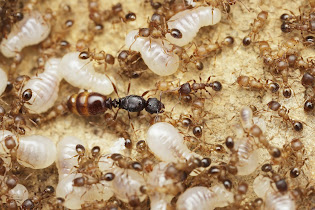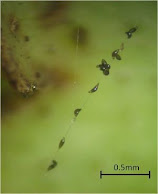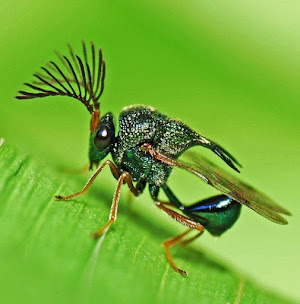It’s Christmastime, and to mark the season I bring you the
Antlered Wasp (
Eucharitidae).
What these
guys lack in size (they’re less than an inch), they make up
for with their large and dramatic antennae. These insects are known as Antlered
Wasps, because with a little imagination, they could be itty bitty reindeer (although some people see their “antlers” as punkish mohawks). And
while it’s entertaining to view them as tiny reindeer, you will not come across
one of these wasps where reindeer reign, as they are tropical insects.
Antlered Wasps, like many other wasps, practice parasitism as a part of their life cycle. And they only parasitize ants, an insect that is often the aggressor in the insect world and not the victim. To put an even finer point on it, each specie (there are over 400 species) specializes in a particular species of ant.
Here is a list of some of those pairings.
Child-rearing in nature is extremely variable, with some
species providing long-term, hands-on care and other species leaving their
offspring to fend for themselves. Antlered Wasps are firmly in the latter
category. When the female is ready to
lay her eggs, she chooses a plant that is a favorite of ants, or one with an
ant colony nearby. She lays her eggs and moves on; after a week to ten days the
larvae will hatch. The larvae will then spend several days lolling about on the
plant, getting their energy and nerve up, and (presumably) planning their strategy
for the next step. The goal of the larvae is to infiltrate the ant
colony, so the next step is to find an ant to take it into
the nest. For this attachment to happen, most
 |
| Ant Queen and her offspring |
Eucharitid wasp larvae depend on
rubbing up against an ant and fastening themselves to it. If there are no available ants around, the wasp
larvae will use an intermediary host that can get them up close enough to grab
an ant. However, according to this article,
the Kapala species in the Eucharitidae family has developed
jumping abilities. Apparently, they will stand up on the leaf and jump down
onto a passing ant. High diving larvae – nature is amazing.
Once a larva has found its Trojan Horse/ant host, it will ride it right into the ant colony. Ants are notoriously and intensely protective of their nests, so how do these larvae get away with this? It seems they have developed the ability to mimic the odor of the ant larvae. Scientists have observed that ants will avoid the adult wasps, a clear indicator that they view them as a threat. But, thanks to the aromatic camouflage, ants seem to not recognize the wasp larvae as different from theirs.
 |
| Ant tending to a newborn wasp |
 |
| Wasp larvae on the move |
The camouflaged wasp larva makes its way, with the unwitting help of the ants, deep into the ant colony’s inner sanctum – the brood chamber. This may be the easiest part of their mission, as the wasp simply has to find an ant larva to attach to. Since a queen ant can lay up to 300,000 eggs a day, there is an abundance of potential hosts for the little wasp. Once attached, the wasp larva will begin feeding on its ant counterpart, but it eats just enough to keep them both going until the ant pupates. Once this happens, the wasp will finish off its host. The wasp uses this last bit of ant fuel to finish growing into an adult and will then emerge from its host. At this point, still helpful and unwitting, ants will feed and groom the newborn as they do their own. Eventually, the wasp will fly out of the colony and mate, usually right above the ant nest.

The life cycle of the Antlered Wasp could be adapted into a Mission Impossible type action movie. And be as unbelievable. Except this is an incredible true story.
Take Care.
Submitted by Pam












No comments:
Post a Comment